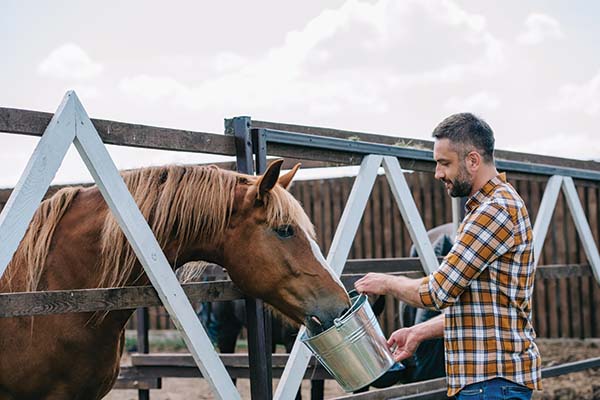Does your horse eagerly whinny when you call to him, or is he silently holding a grudge from last week’s reprimand? A recent study from France shows that horses respond to voice and the complex array of emotions sparked are linked to his past experiences.

Right vs. Left Brain
Studies have proven that horses assimilate sounds in distinctly different ways. Negative, stressful, or alarming sounds are processed in the right hemisphere of the brain, while positive sounds, such as the rumble of the feed truck, are processed in the left hemisphere.
Additionally, the horse’s senses, particularly his ears and eyes, are laterally—or oppositely—connected to the brain hemispheres. When a horse looks with his left eye, for example, the right hemisphere of his brain is activated, and when he uses his right eye, the opposite occurs.
A horse that senses an emergency situation will use his left eye and left ear to assess the level of threat. Knowing this information allows researchers to determine how information is perceived emotionally by the horse. A happy, social situation will be “looked upon” from the right-side senses (and the left brain hemisphere is activated), while terrifying situations—such as that ghostly plastic bag in the wind—is predominantly viewed from the left (with right brain hemisphere activation).
How the Study Worked
Based on prior studies of how horses respond to voice, the research crew hypothesized that the horse, even when deprived of other information, such as the familiarity of an owner or facial expressions, would connect a voice to a singular experience.
The study included 21 horses. Over a period of seven days, each horse was exposed to two different scenarios: one in which they were given a tasty bucket of food, and another where they were given the same meal, but this time the food was mixed with vinegar, making it inedible—and frustrating.
The “voice,” a continuous recording of a person reading a script, came from a small loudspeaker worn around the neck of the handler. The voices on the loudspeaker were different for the positive and negative experiences, however.
To provide a balanced assessment, 10 of the horses were from a riding center. These horses lived in stalls and were regularly used for riding lessons. The other 11 horses lived in a pasture environment. They were casually ridden and had daily interactions with people. This second group had continual access to grass or hay, while the riding center horses had more scheduled feed times and less access to roughage.

After the seven-day exposure period, the research team tested each horse. This time an unknown handler led the horse, and the voice on the loudspeaker was broadcast without food. Two video cameras were used to record the horse’s response to the voice for later analysis.
Additionally, 17 of the 21 horses were comfortably outfitted with a portable elecroencephalogram (EEG) helmet on the horse’s head in order to measure the horse’s brain waves. The EEG showed the team which side of the brain was most active during each experiment.
The Conclusion: Horses Respond to Voice
The results were not surprising. Combining the three methods of analysis, the researchers were able to conclude that there is a definite connection between sound and equine response. The team determined from the video that the food treat and coinciding voice was met with a significant increase in ears forward, attentive posture, and approach behavior. In particular, three horses pulled on the lead, with one nickering when the voice was played.
In contrast, the voice associated with the vinegar-laced food was met with an ears-back response and avoidance, with seven of the horses pulling on the lead to move away from the sound. The video also confirmed that for the positive experience, the right eye (associated with positive emotions) was used more frequently, while during the negative experience, the left eye (correlated with fear and anxiety) was significantly more engaged.
Finally, the EEG results, which measured gamma waves, confirmed the hypothesis. The positive experience showed a heightened increase in gamma waves in the right brain hemisphere. Activation of gamma waves are an indication of memory and recall—and, the researchers suspect, the expectation of a future positive event.
Though the difference was small, the researchers also noted that the pasture horses, likely because they were less dependent on the voice-related food supply, showed less frustration at the vinegar food mix.
This study confirms that the bond between humans and horses is by nature emotional, and that the quality of interactions between the two is heard—and remembered. The researchers hope that this study continues to add more information to the growing field of horse welfare.
This article about how horses respond to the human voice appeared in the October 2020 issue of Horse Illustrated magazine. Click here to subscribe!





